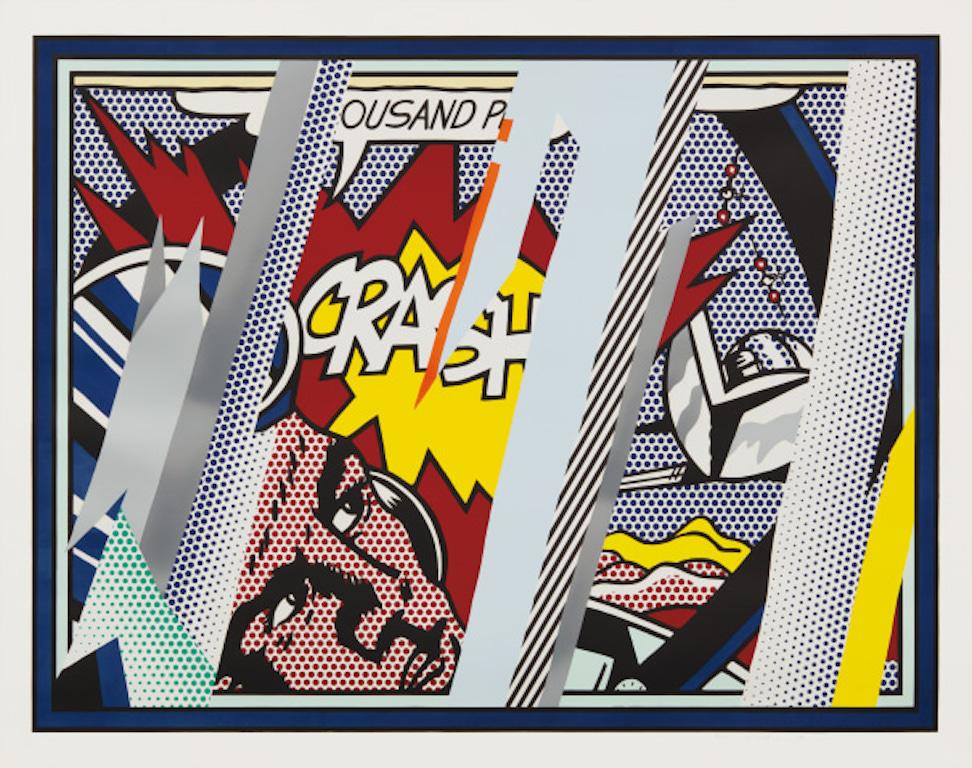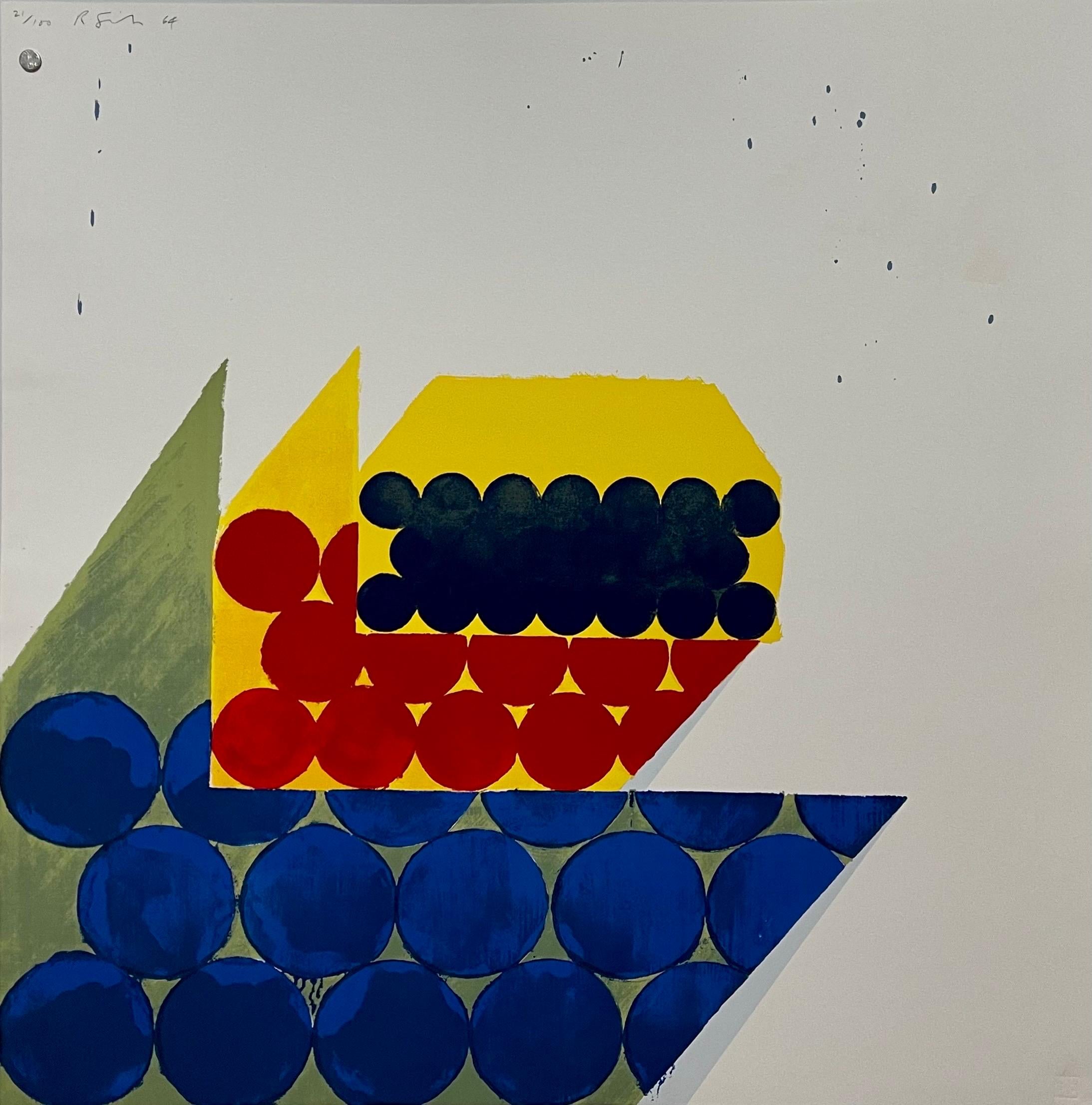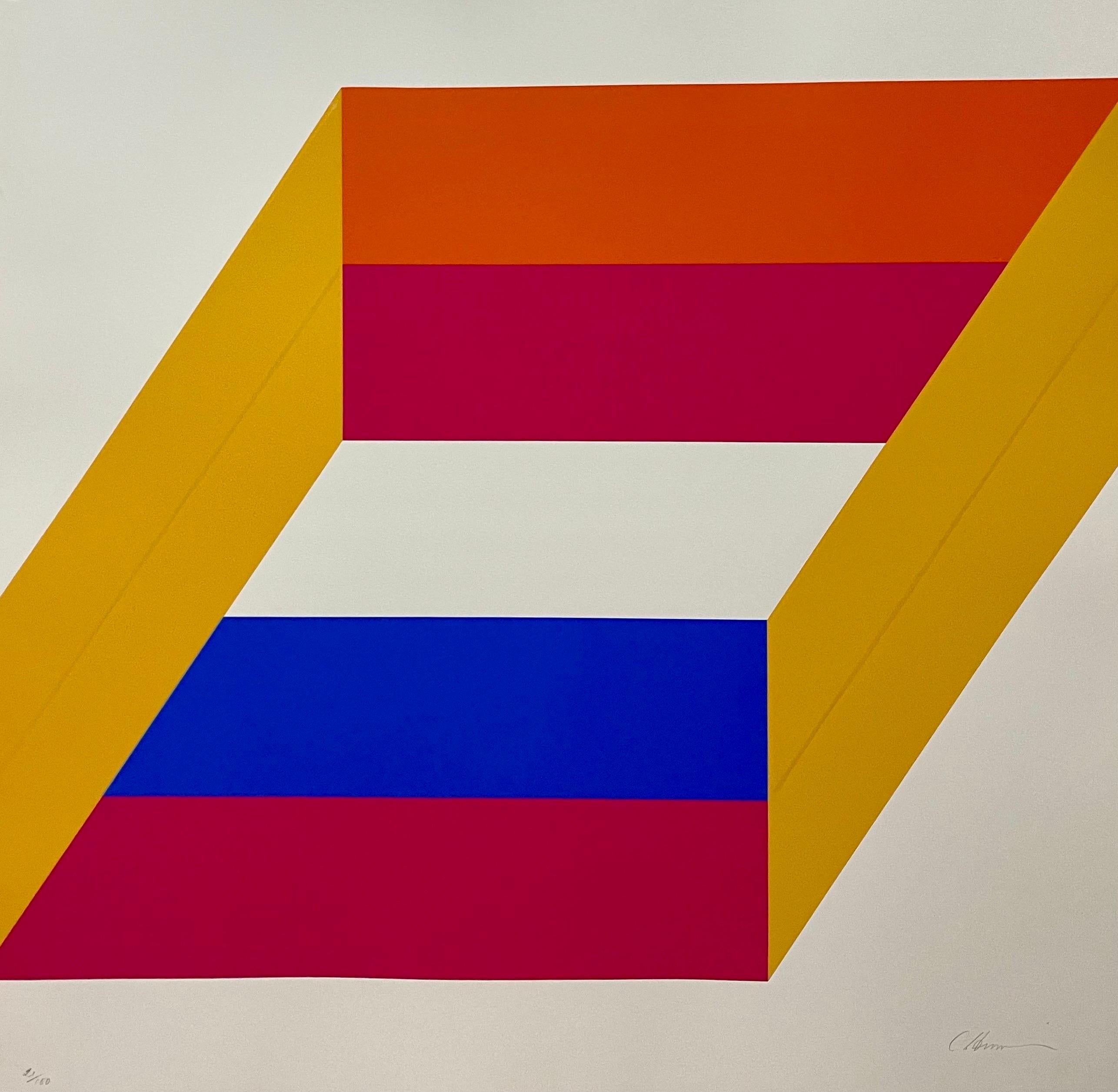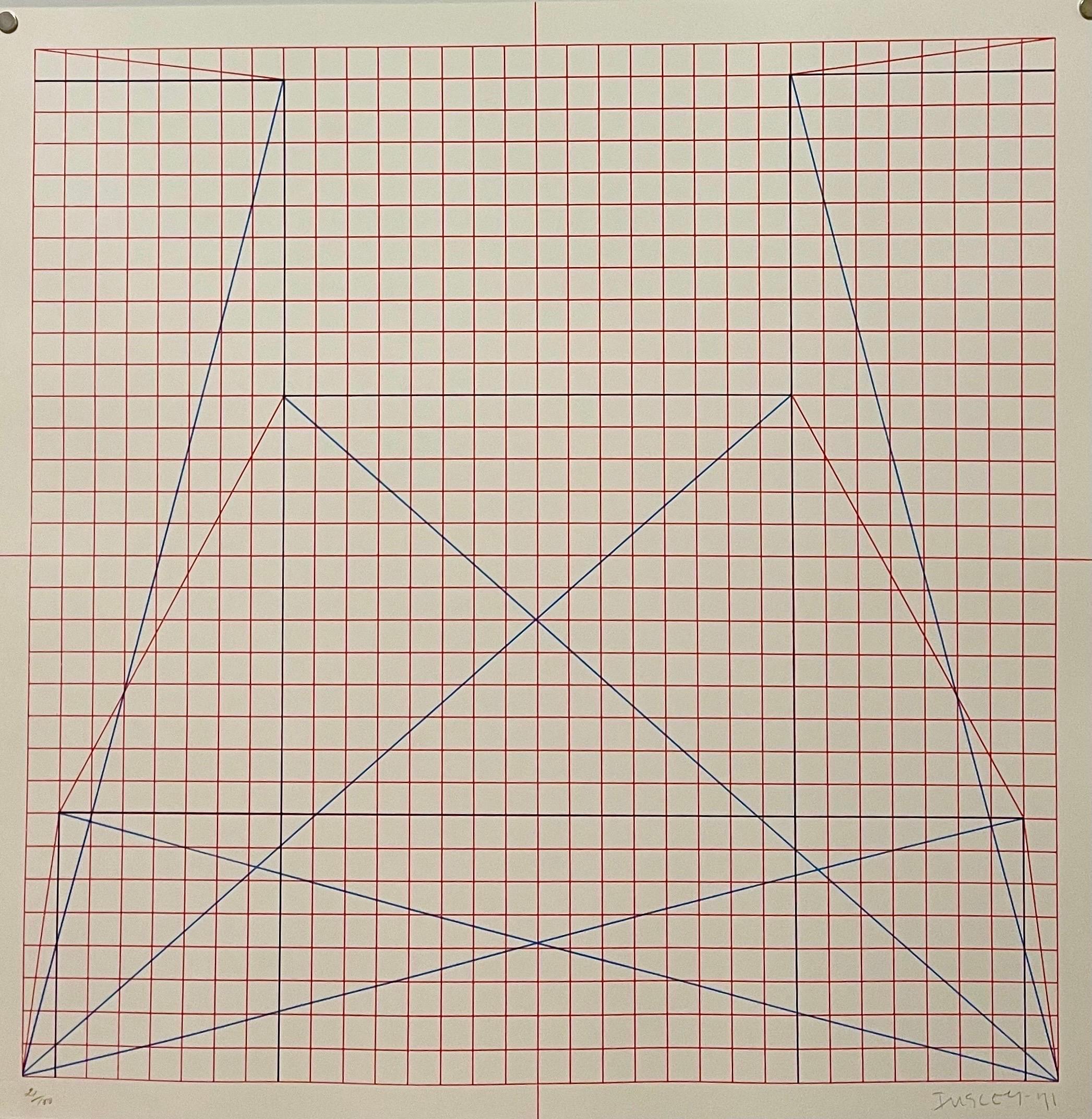Roy LichtensteinRoy Lichtenstein "Figures" 1978 (From Surrealist Series) Gemini G.E.L. Printers 1978
1978
About the Item
- Creator:Roy Lichtenstein (1923 - 1997, American)
- Creation Year:1978
- Dimensions:Height: 35 in (88.9 cm)Width: 26 in (66.04 cm)
- Medium:
- Movement & Style:
- Period:
- Condition:
- Gallery Location:Detroit, MI
- Reference Number:1stDibs: LU1286112744522
Roy Lichtenstein
Roy Lichtenstein is one of the principal figures of the American Pop art movement, along with Andy Warhol, James Rosenquist, Claes Oldenburg and Robert Rauschenberg.
Drawing inspiration from comic strips, Lichtenstein appropriated techniques commercial printing in his paintings, introducing a vernacular sensibility to the visual landscape of contemporary art. He employed visual elements such as the halftone dots that comprise a printed image, and a comic-inspired use of primary colors gave his paintings their signature “Pop” palette.
Born and raised in New York City, Lichtenstein enjoyed Manhattan’s myriad cultural offerings and comic books in equal measure. He began painting seriously as a teenager, studying watercolor painting at the Parsons School of Design in the late 1930s, and later at the Art Students League, where he worked with American realist painter Reginald Marsh. He began his undergraduate education at Ohio State University in 1940, and after a three-year stint in the United States Army during World War II, he completed his bachelor’s degree and then his master’s in fine arts. The roots of Lichtenstein’s interest in the convergence of high art and popular culture are evident even in his early years in Cleveland, where in the late 1940s, he taught at Ohio State, designed window displays for a department store and painted his own pieces.
Working at the height of the Abstract Expressionist movement in the 1950s, Lichtenstein deliberately eschewed the sort of painting that was held in high esteem by the art world and chose instead to explore the visual world of print advertising and comics. This gesture of recontextualizing a lowbrow image by importing it into a fine-art context would become a trademark of Lichtenstein’s artistic style, as well as a vehicle for his critique of the concept of good taste. His 1963 painting Whaam! confronts the viewer with an impact scene from a 1962-era issue of DC Comics’ All American Men of War. Isolated from its larger context, this image combines the playful lettering and brightly colored illustration of the original comic with a darker message about military conflict at the height of the Cold War. Crying Girl from the same year featured another of Lichtenstein’s motifs — a woman in distress, depicted with a mixture of drama and deadpan humor. His work gained a wider audience by creating a comic-inspired mural for the New York State Pavilion of the 1964 World's Fair, he went on to be represented by legendary New York gallerist Leo Castelli for 30 years.
In the 1970s and ’80s, Lichtenstein experimented with abstraction and began exploring basic elements of painting, as in this 1989 work Brushstroke Contest. In addition to paintings in which the brushstroke itself became the central subject, in 1984 he created a large-scale sculpture called Brushstrokes in Flight for the Port Columbus International Airport in Ohio. Still Life with Windmill from 1974 and the triptych Cow Going Abstract from 1982 both demonstrate a break from his earlier works where the subjects were derived from existing imagery. Here, Lichtenstein paints subjects more in line with the norms of art history — a pastoral scene and a still life — but he has translated their compositions into his signature graphic style, in which visual elements of printed comics are still a defining feature.
Lichtenstein’s work is represented in the collections of the Metropolitan Museum of Art, the Museum of Modern Art, Tate Modern, and many others. He was awarded National Medal of Arts in 1995, two years before he passed away.
Find a collection of Roy Lichtenstein prints, drawings and more on 1stDibs.
- ShippingRetrieving quote...Ships From: Detroit, MI
- Return PolicyA return for this item may be initiated within 14 days of delivery.
- Jean Dubuffet Lithograph Art Brut "I. Traces grotesques"By Jean DubuffetLocated in Detroit, MISALE ONE WEEK ONLY "I. Traces grotesques" is an Artist’s Proof Lithograph. “Proofs” are either pulled or printed, and the artist has the option to work out the color and quality issues as they come out of the process. The only real difference between the two is the restricted quantity of prints bearing the AP designation and not the quality of the print. This lithograph is signed and titled by the artist, Jean Dubuffet, which indicates his complete satisfaction with the print. It is from 1958 and a perfect example of his style, “Art Brut.” His idealistic approach to aesthetics embraced what is called “low art”, art by non-academically trained artists. It is sometimes referred to as “outsider art.” He did study briefly at the Academie Julian, Paris, but eventually followed his own aesthetics which eschewed traditional standard of beauty in favor of what he believed to be a more authentic and humanistic approach to image-making. This lithograph expresses the beauty he found in the meandering spontaneous black line. Jean Dubuffet began painting at the age of seventeen and studied briefly at the Academie Julian, Paris. He painted off and on for the next 20 years. It was not until 1942 in the midst of WWII in France that he began the work which has distinguished him as an outstanding innovator in postwar Europe. It is said of his work that “he looked to the margins of the everyday – the art of prisoners, psychics, the uneducated, and the institutionalized – to liberate his own creativity and coining the term ‘Art Brut’.” Art Brut is a French term that translates as ‘raw art’, to describe art such as graffiti or naïve art which is made outside the academic tradition of fine art. His paintings from the early forties in brightly colored oils were soon followed by works in which he employed such unorthodox materials as cement, plaster, tar and asphalt-scraped, craved and cut and drawn upon with a rudimentary, spontaneous line. Dubuffet worked in France and exhibited from the early forties on. He was included in the 1946 Pierre Matisse...Category
1950s Abstract Abstract Prints
MaterialsLithograph
- "Untitled I", Abstract Etching and Aquatint Lithograph, Signed and NumberedBy Bert YarboroughLocated in Detroit, MI"Untitled I" is a work that displays Bert Yarborough's experimentation with emotion and monotype in his abstract and expressive style. This print made ...Category
1990s Abstract Prints
MaterialsEtching, Aquatint, Lithograph, Monotype
- "Untitled II", Abstract Etching and Aquatint Lithograph, Signed and NumberedBy Bert YarboroughLocated in Detroit, MI"Untitled II" is a work that displays Bert Yarborough's experimentation with emotion and monotype in his abstract and expressive style. This print made...Category
1990s Abstract Prints
MaterialsEtching, Aquatint, Lithograph, Monotype
- "Untitled IV", Abstract Aquatint Color Etching Lithograph, Signed and NumberedLocated in Detroit, MI"Untitled IV" is a work that displays James Hansen's intense colors and shapes of his abstract and surrealist style. This print made with etching and aquatints with hand-coloring on Arches paper pops with the illusion of three dimensions set against a muted background of esoteric shapes and symbols. The print is 32-3/4 x 25-3/4 inches and is signed and numbered from an edition of 30 by the artist. Numbered edition may not necessarily be number 20 as there are multiple prints in the possession of Collected Detroit. James Hansen was born in 1951 in New Haven, Connecticut and spent most of his artistic career in Provincetown, Massachusetts where he befriended and worked with Paul Bowen, Claude Simard...Category
1990s Abstract Prints
MaterialsEtching, Lithograph, Aquatint
- "Untitled II", Abstract Aquatint Color Etching Lithograph, Signed and NumberedLocated in Detroit, MI"Untitled II" is a work that displays James Hansen's intense colors and shapes of his abstract and surrealist style. This print made with etching and aquatints with hand-coloring on Arches paper pops with the illusion of three dimensions set against a muted background of esoteric shapes and symbols. The print is 32-3/4 x 26 inches and is signed and numbered from an edition of 30 by the artist. Numbered edition may not necessarily be number 28 as there are multiple prints in the possession of Collected Detroit. James Hansen was born in 1951 in New Haven, Connecticut and spent most of his artistic career in Provincetown, Massachusetts where he befriended and worked with Paul Bowen, Claude Simard...Category
1990s Abstract Prints
MaterialsEtching, Aquatint, Lithograph
- "Untitled I", Abstract Aquatint Color Etching Lithograph, Signed and NumberedLocated in Detroit, MI"Untitled I" is a work that displays James Hansen's intense colors and shapes of his abstract and surrealist style. This print made with etching and aquatints with hand-coloring on Arches paper pops with the illusion of three dimensions set against a muted background of esoteric shapes and symbols. The print is 32-3/4 x 25-3/4 inches and is signed and numbered from an edition of 30 by the artist. Numbered edition may not necessarily be number 12 as there are multiple prints in the possession of Collected Detroit. James Hansen was born in 1951 in New Haven, Connecticut and spent most of his artistic career in Provincetown, Massachusetts where he befriended and worked with Paul Bowen, Claude Simard...Category
1990s Abstract Prints
MaterialsEtching, Aquatint, Lithograph
- Reflections on CrashBy Roy LichtensteinLocated in New York, NY1990 Lithograph, screenprint on paper and metalised PVC on paper S. 59 1/8 x 75 in. (150.2 x 190.5 cm) Edition of 68 Signed, dated and numbered in pencil, lower marginCategory
1990s Pop Art Abstract Prints
MaterialsPaper, Lithograph, Screen
- Echo Pale, From Mirrors of the Mind Portfolio, 1975By James RosenquistLocated in Brecon, PowysJames Rosenquist (American 1933-2017) Echo Pale, From Mirrors of the Mind Portfolio, 1975 signed and dated 'Rosenquist 1975' (lower right); titled and numbered 74/100 lithograph, un...Category
1970s Pop Art Abstract Prints
MaterialsLithograph
- Abstract Minimalist Color Silkscreen Print Richard Smith On The Bowery Pop ArtBy Richard SmithLocated in Surfside, FLRichard Smith On the Bowery, 1969 - 1971 silkscreen on Schoeller's Parole Paper, edition of 100 + 20 A.P. 25.5 x 25.5 inches, signed, numbered 21/100 Screenprint in color on wove paper Hand signed, published by Edition Domberger, Bonlanden, West Germany (with their blindstamp) Provenance: Collection of Tom Levine On the Bowery, 1971. The portfolio consists of nine screenprints in colors (one with mylar collage), on wove paper, by representative artists of the Pop Art period. Cy Twombly, Robert Ryman, Will Insley, Robert Indiana, Les Levine, John Willenbecher...Category
1960s Pop Art Abstract Prints
MaterialsLithograph, Screen
- 1969-71 Abstract Minimalist Color Silkscreen Print Charles Hinman On The BoweryBy Charles HinmanLocated in Surfside, FLCharles Hinman On the Bowery, 1969 - 1971 silkscreen on Schoeller's Parole Paper, edition of 100 + 20 A.P. 25.5 x 25.5 inches, signed, numbered 21/100 Screenprint in color on wove paper Hand signed, published by Edition Domberger, Bonlanden, West Germany (with their blindstamp) Provenance: Collection of Tom Levine On the Bowery, 1971. The portfolio consists of nine screenprints in colors (one with mylar collage), on wove paper, by representative artists of the Pop Art period. Cy Twombly, Robert Ryman, Will Insley, Robert Indiana, Les Levine, John Willenbecher...Category
1960s Pop Art Abstract Prints
MaterialsScreen, Lithograph
- Color Silkscreen Pop Art Lithograph Print Les Levine Canadian Pop Art PortraitBy Les LevineLocated in Surfside, FLLes Levine On the Bowery, 1969 - 1971 Screenprint in color 25.5 x 25.5 inches, signed, numbered 21/100 Hand signed, published by Edition Domberger, Bonlanden, West Germany (with their blindstamp) Provenance: Collection of Tom Levine On the Bowery, 1971. The portfolio consists of nine screenprints in colors (one with mylar collage), on wove paper, by representative artists of the Pop Art period. Cy Twombly, Robert Ryman, Will Insley, Robert Indiana, Les Levine, John Willenbecher...Category
1960s Pop Art Abstract Prints
MaterialsLithograph, Screen
- Abstract Minimalist Color Silkscreen Print Will Insley On The Bowery Pop ArtLocated in Surfside, FLWill Insley On the Bowery, 1969 - 1971 silkscreen on Schoeller's Parole Paper, edition of 100 + 20 A.P. 25.5 x 25.5 inches, signed, numbered 21/100 Screenprint in color on wove paper Hand signed, published by Edition Domberger, Bonlanden, West Germany (with their blindstamp) Provenance: Collection of Tom Levine On the Bowery, 1971. The portfolio consists of nine screenprints in colors (one with mylar collage), on wove paper, by representative artists of the Pop Art period. Cy Twombly, Robert Ryman, Will Insley, Robert Indiana, Les Levine, John Willenbecher...Category
1960s Pop Art Abstract Prints
MaterialsLithograph, Screen






